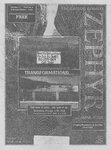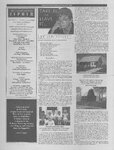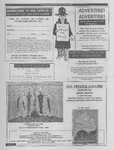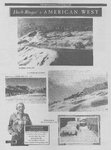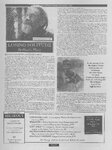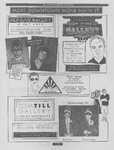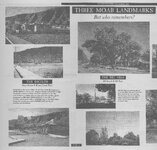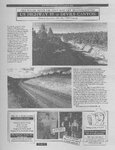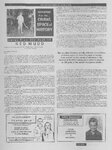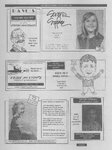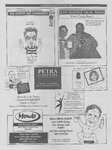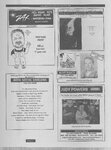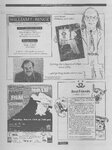| OCR Text |
Show THE ZEPHYR/FEBRUARY-MARCH THE CANYON COUNTRY ZEPHYR PO BOX 327 MOAB, UTAH 84532 Jim Stiles, publisher 435.260.1273 www.canyoncountryzephyr.com ce 2006 field and my brother and I often waved to the hobos who made their way along the two-track path from Six Mile Lane ee and the Southern Railroad tracks, to the L & N Railway in Crescent Hill. In those days, talking to tramps didn’t seem like a hazardous gesture, even to my parents. And when I aa was all of five years old, and my mother turned me loose to Beeds Lhe cczephyr@frontiernet.net moabzephyr@yahoo.com contributing writers Ken Sleight Martin Murie Ned Mudd Barry Scholl Chinle Mille Scott Silver Philip Hyde Lance Christie Wendell Berry Erica Walz the artist John Depuy historic photographs Herb Ringer (1913-1998) Zephyr pilot & aerial reconaissance Paul Swanstrom Zephyr Transportation Fleet Specialists Gene Schafer Tom Wesson webmaster Gary Henderson | BY JMS? Pees GOLDEN MEMORIES on GLEN MEADE ROAD Oft in the stilly night, Ere Slumber’s chain has bound me, Fond Memory brings the light Of other days around me: The smiles, the years Of boyhood’s years, The words of love then spoken: The eyes that shone, Now dimmed and gone, The cheerful hearts now broken. explore The Woods at the end of the street (not to be confused ‘with the Big Woods across the field) I never felt so free in my very short life. I suppose I’ve been pursuing that kind of freedom ever since. None of us kids realized how lucky we were at the time. Playing in the woods and building tree houses and hiding in the cane breaks and trying to find the bottom of the bottomless swamp was our world. It was all we knew and it was enough. I knew every tree in those Woods on an intimate basis. We knew which ones were candidates for tree ladders and platforms. We knew which were good climbing trees. We usually knew which trees were wrapped in heavy poison ivy - vines and if we didn’t, the hideous rashes that subsequently " covered me from head to toe were our after-the-fact warnings. I remember a piece of cut limestone, at the far northeast corner of the Woods that was a constant source of mystery for us. Why a chunk of rock could have held our fascination for so long, I’ll never know. All little boys love a mystery I guess and this is the best we could come up with. We wondered who’d put it there and wondered why and wondered how long it had been there. Someone suggested that maybe one of the original Kentucky pioneers had placed the stone obelisk in the ground. Maybe Daniel Boone or James Harrod or George Rogers Clark. Someone ...Michael Pottinger? Timmy Kremer? I can’t recall who, tried to dig it up but could never find the bottom of the rock. The mystery took on new dimensions. Thomas Moore How would any of us survive if it weren’t for the soft and muted golden glow that the passage of time blesses us with? I doubt if my childhood was nearly as idyllic as 1 now remember it, and in fact, I can still dredge up enough bad memories to give me pause right now, that my dreamy recollections don’t quite fit with Reality. But then I remember the conversation between Elwood P. Dowd, best friend to a six and a half foot tall invisible rabbit Subscriptions & transcriptions Linda Vaughan cireulation JA Bryan Lance Lawrence Jose Churampi Mark Anderson Kathy Aldous THE ZEPHYR, copyright 2006 The Zephyr is published six times a year at Moab, Utah. The opinions expressed herein are not necessarily those of its vendors, advertisers, or even at times, of its publisher. All photos and cartoons are by the publisher unless otherwise noted named Harvey (a pooka) and the celebrated psychiatrist. The good doctor said, “Mr. Dowd, isn’t time you faced Reality?” Elwood thought a moment and replied, “Doctor, I’ve been fighting Reality for 35 years and I’m happy to say I finally won out over it..” 3723 GLEN MEADE ROAD in the late 50s and in 2004 Maybe that’s the best kind of memory...the kind we want to have. But I do know this. I know that despite the eternal ordeal of childhood and the conflicts we all face at an early age with family and friends and strangers alike, we did have more time then to be kids. We may have been the last generation of children given the chance to create our own childhoods. In another ramble a few months ago, I recall sharing a new ailment now consuming America’s youth. Doctors call it “nature deficit disorder,” and there’s scarcely a child growing up in Urban America today who isn’t afflicted by this disconnection between kids and the natural world. I am so grateful I was spared this “sickness,” grateful that it hadn’t been invented yet. There were times when my None of us kids realized at the time how lucky we were. Playing in the Woods was our world. If was all we knew and if was enough. frequent bouts with poison ivy and chigger bites, contracted out there doing intimate duty with the “natural world,” were so miserable, I might have welcomed the tradeoff. In the end, though, years after the blisters heeled and the swelling went down, I wouldn’t have wanted to miss a single itch. ...-tried to go back as if | could, all spec house and plywood. Tore up tore up good, down on Copperline. It doesn't come as a surprise to me, It doesn't touch my memory. Pree ata emo omelet Murs iaved iy-1-F Down on Copperline. James Taylor The Swamp, in retrospect, was a godawful place. It was a slime-filled garbage dump more than anything else. And yet, for some reason, we felt compelled to wade through the swamp, in search of treasures and, at one end, the bottom. There were those among us who insisted that it was indeed bottomless and I would swear that on at least one occasion, I saw one of my buddies dive under the green slime and the garbage in search of it. That was more courage than I could muster. Before we i even outgrew the Woods and the Swamp, however, Progress began to take them away from us. One THE GLEN MEADE ROAD GANG (I to r) Jimbo Stiles, Pam Kotheimer, Peter Caldwell, David Kotheimer, Jeff Stiles, Timmy Kremer The American Suburb was just beginning to dominate the landscape when my family moved from a small downtown apartment to one of the first subdivisions to take root in east Louisville, Kentucky, almost half a century ago. Glen Meade Road was a solitary finger of small two-bedroom brick homes in an area that had been farm land for almost two centuries. We were surrounded by dense woods and wheat fields and bottomless swamps and a pumpkin patch. A dirt road ran behind Glen Meade, on the edge of Old Lady Huntsinger’s morning, when I could not have been more than seven, my father was shaving and I was stepping up on my box to use the toilet. With the box booster I could just barely see out the back window toward Miss Huntsinger’s field and the vast forest, the Big Woods, that lay on the other side. Even then, I found such sights comforting and pleasing to my eye. On this morning however, I was shaken by an ugly and unfamiliar sight. Lined bumper to bumper on the far side of the wheat . field, there must have been ten earth movers and graders. I could not imagine what they were doing there and so I asked my father. He put down his razor and stared out the window with me. “That's construction equipment,” he said. “They’re building another subdivision, just like this one.” |
